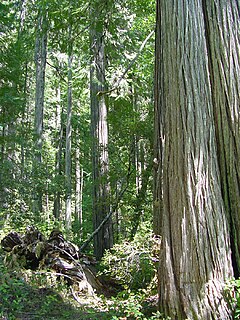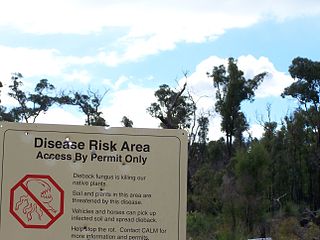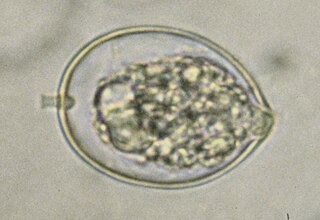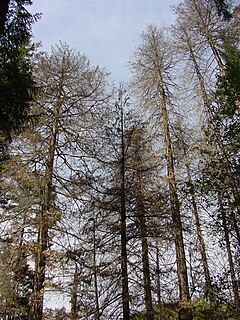Blight refers to a specific symptom affecting plants in response to infection by a pathogenic organism.

Chamaecyparis lawsoniana, known as Port Orford cedar or Lawson cypress, is a species of conifer in the genus Chamaecyparis, family Cupressaceae. It is native to Oregon and northwestern California, and grows from sea level up to 1,500 m (4,900 ft) in the valleys of the Klamath Mountains, often along streams.

Phytophthora is a genus of plant-damaging oomycetes, whose member species are capable of causing enormous economic losses on crops worldwide, as well as environmental damage in natural ecosystems. The cell wall of Phytophthora is made up of cellulose. The genus was first described by Heinrich Anton de Bary in 1875. Approximately 170 species have been described, although 100–500 undiscovered Phytophthora species are estimated to exist.

Phytophthora ramorum is the oomycete plant pathogen known to cause the disease sudden oak death (SOD). The disease kills oak and other species of trees and has had devastating effects on the oak populations in California and Oregon, as well as being present in Europe. Symptoms include bleeding cankers on the tree's trunk and dieback of the foliage, in many cases leading to the death of the tree.

Phytophthora cinnamomi is a soil-borne water mould that produces an infection which causes a condition in plants variously called "root rot", "dieback", or, "ink disease". The plant pathogen is one of the world's most invasive species and is present in over 70 countries around the world.

Phytophthora palmivora is an oomycete that causes bud-rot of palms, fruit-rot or kole-roga of coconut and areca nut. These are among the most serious diseases caused by fungi and moulds in South India. It occurs almost every year in Malnad, Mysore, North & South Kanara, Malabar and other areas. Similar diseases of palms are also known to occur in Sri Lanka, Mauritius, and Sumatra. The causative organism was first identified as Phytophthora palmivora by Edwin John Butler in 1917.

Phytophthora cactorum is a plant pathogen that causes root rot on rhododendron and many other species.
Phytophthora nicotianae or black shank is an oomycete belonging to the order Peronosprales and family Peronosporaceae.
Phytophthora inflata is an oomycete plant pathogen. It was first identified in 1949 in Michigan, USA causing a pit canker on elm trees. It was found in the United Kingdom in 1992 in the roots of Sambucus tenuifolium and Lilac, in 2003 it was found in a UK nursery infecting Rhododendron ponticum. In the same year it was found in a nursery in Ohio also infecting Rhododendron.

Phytophthora lateralis is a soil-borne plant pathogen that causes cedar root disease in Lawson cypresses in Northern USA. This pathogen was first noted to cause disease in around 1920 on nursery stock near Seattle. Pacific yew is also vulnerable to P. lateralis but less susceptible than Lawson cypress trees, and tree mortality has only been observed in areas where C. lawsoniana trees were also infected. Asiatic species of Chamaecyparis are generally described as resistant to P. lateralis, although this pathogen is occasionally isolated from Chamaecyparis obtusa in nurseries.
Phytophthora megakarya is an oomycete plant pathogen that causes black pod disease in cocoa trees in west and central Africa. This pathogen can cause detrimental loss of yield in the economically important cocoa industry, worth approximately $70 billion annually. It can damage any part of the tree, causing total yield losses which can easily reach 20-25%. A mixture of chemical and cultural controls, as well as choosing resistant plant varieties, are often necessary to control this pathogen.

Gymnosporangium sabinae is a fungal heteroecious plant pathogen with Juniperus as the primary (telial) host and only Pyrus as secondary (aecial) hosts. It is one of many types of rust fungi affecting plants.

Phytophthora kernoviae is a plant pathogen that mainly infects European beech and Rhododendron ponticum. It was first identified in 2003 in Cornwall, UK when scientists were surveying for the presence of Phytophthora ramorum. This made it the third new Phytophthora species to be found in the UK in a decade. It was named Phytophthora kernoviae, after the ancient name for Cornwall, Kernow. It causes large stem lesions on beech and necrosis of stems and leaves of Rhododendron ponticum. It is self-fertile. It has also been isolated from Quercus robur and Liriodendron tulipifera. The original paper describing the species, stated it can infect Magnolia and Camellia species, Pieris formosa, Gevuina avellana, Michelia doltsopa and Quercus ilex. Since then many other plants have been identified as natural hosts of the pathogen. Molecular analysis has revealed that an infection on Pinus radiata, recorded in New Zealand in 1950, was caused by P. kernoviae.

Kauri dieback is a forest dieback disease of the native kauri trees of New Zealand caused by the oomycete pathogen Phytophthora agathidicida. Symptoms include root rot and associated rot in a collar around the base of the tree, bleeding resin, yellowing and chlorosis of the leaves followed by extensive defoliation, and finally, death.
Phytophthora quercina is a papillate homothallic soil-borne plant pathogen causing root rot of oak tree species in Europe. It is associated with necrotic fine roots.
Black pod disease is a protozoal disease of Cocoa trees. This pathogen if left untreated can destroy all yields; annually the pathogen can cause a yield loss of up to 1/3 and up to 10% of total trees can be lost completely. With the value of the cocoa industry throughout the world being so large there are much research and control efforts that go into these Phytophthora spp. pathogens.
Collar rot is a symptomatically described disease that is usually caused by any one of various fungal and oomycete plant pathogens. It is present where the pathogen causes a lesion localized at or about the collet between the stem and the root. The lesions develop around the stem eventually forming a "collar". Observationally, collar rot grades into "basal stem rot", and with some pathogens is the first phase of "basal stem rot" often followed by "root rot". Collar rot is most often observed in seedings grown in infected soil. The pathogens that cause collar rot may be species or genera specific. But generalist pathogens such as Athelia rolfsii are known to attack over 200 different species. While bacteria caused collar rot is not common, trees infected with Fire blight may develop collar rot. Non-parasitic collar rot may be caused by winter damage.
Phytophthora polonica is a non-papillate homothallic plant pathogen known to infect alder species.
Black rot on orchids is caused by Pythium and Phytophthora species. Black rot targets a variety of orchids but Cattleya orchids are especially susceptible. Pythium ultimum and Phytophthora cactorum are known to cause black rot in orchids.
Cranberry Root Rot (CRR) is a disease in cranberries that can cause a decline in yield.









